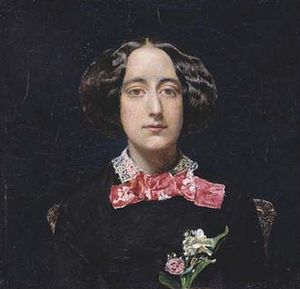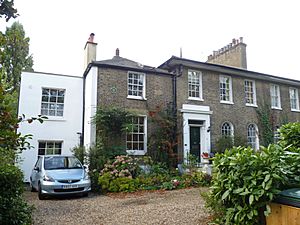Coventry Patmore facts for kids
Quick facts for kids
Coventry Patmore
|
|
|---|---|

Portrait of Coventry Patmore, by John Singer Sargent, 1894.
|
|
| Born | Coventry Kersey Dighton Patmore 23 July 1823 Essex, England |
| Died | 26 November 1896 (aged 73) Lymington, England |
| Occupation | Poet and critic |
| Signature | |
Coventry Kersey Dighton Patmore (born July 23, 1823 – died November 26, 1896) was an English poet and writer who reviewed books and art. He is most famous for his long poem called The Angel in the House. This poem describes the ideal happy marriage in the Victorian era, which was a time when Queen Victoria ruled England.
When he was young, Patmore worked at the British Museum in London. After his first book of poems came out in 1844, he met artists from the Pre-Raphaelite Brotherhood. Later, his first wife died, and his sadness became a big part of his poems. Today, Patmore is not as well-known as some other Victorian poets, but many people who study poetry think he was very good.
Contents
Life of Coventry Patmore
Early Life and Education
Coventry Patmore was born in Woodford, Essex, England. He was the oldest son of an author named Peter George Patmore. Coventry was taught at home and spent a lot of time with his father. From his father, he learned to love books and writing early on.
Coventry dreamed of becoming an artist. He was very good at drawing and even won a silver award from the Royal Society of Arts in 1838. In 1839, he went to school in France for six months. There, he started writing poetry. When he came back, his father wanted to publish his poems. But Coventry became interested in science, so he stopped writing poetry for a while.

Around this time, Coventry's father had money problems. In 1846, a friend helped Coventry get a job at the British Museum. He worked there for 19 years. During this time, he spent his free hours writing poetry.
Family Life
In 1847, Coventry married Emily Augusta Andrews. They had two sons, Coventry (born 1848) and Tennyson (born 1850). Later, they had three daughters: Emily (born 1853), Bertha (born 1855), and Gertrude (born 1857). Their last child, a son named Henry John, was born in 1860.
By 1861, the family lived in Hampstead. Sadly, Emily died on July 5, 1862, after being sick for a long time. After her death, Coventry joined the Roman Catholic church.
In 1865, he married again to Marianne Byles. A year later, he bought a large house called Buxted Hall. He even wrote a book about how he managed his property.
His second wife, Marianne, died in 1880. In 1881, he married Harriet Robson. Their son, Francis, was born in 1882. In his later years, Coventry Patmore lived in Lymington, where he passed away in 1896. He was buried in the local churchyard.
Becoming a Poet
Coventry Patmore started writing poetry again because he was inspired by the success of Alfred, Lord Tennyson. In 1844, he published a small book called Poems. It was original but not always smooth. Patmore was upset by how it was received, especially a harsh review. He bought and destroyed the remaining copies of the book. However, his friends' support and helpful ideas encouraged him to keep writing.
Because of this book, he met other writers like Dante Gabriel Rossetti. Through Rossetti, Patmore met William Holman Hunt and became part of the Pre-Raphaelite Brotherhood. He even wrote a poem called "The Seasons" for their magazine, The Germ.
While working at the British Museum, Patmore helped start the Volunteer Movement in 1852. He wrote an important letter to The Times newspaper about it. This helped create a lot of excitement for the movement among his co-workers.
Coventry Patmore's Main Works

In 1853, he republished Tamerton Church Tower, which was a more successful poem from his 1844 book. He added new poems that showed he was getting better at writing. The next year, 1854, the first part of his most famous poem, The Angel in the House, came out.
The Angel in the House is a long poem that tells a story and also expresses feelings. It has four parts that he wrote over several years. The first two parts, The Betrothed and The Espousals (1856), praise his first wife. These were followed by Faithful For Ever (1860) and The Victories of Love (1862). All four parts were published together in 1863. This poem became a symbol of what Victorians thought was the perfect woman and marriage.
In 1877, he published The Unknown Eros. Many people believe this book contains his best poetry. The next year, his favorite poem, Amelia, was published. It came with an interesting essay about English Metrical Law, which is about the rules of poetry. He continued writing about criticism in 1879 with a book called Principle in Art, and again in 1893 with Religio Poetae.
What People Thought of His Work
A collection of Patmore's poems was published in 1886. In the introduction, he wrote something important about his work. He said he wrote little, but it was all his best. He always took time and effort to make his words true. He hoped that future generations who cared about literature would respect his work. This shows how honest he was, and also a bit innocent, which are two main parts of his early poetry.

His best work is found in the poems called The Unknown Eros. This book has many parts and whole poems where deep thoughts are shared in beautiful and strong language. His poems are full of spiritual ideas and feel very much alive. For example, his wonderful poem praising winter, the serious and lovely rhythm of "Departure," and the simple but moving sadness of "The Toys" are among the best in English poetry.
Coventry Patmore also had strong opinions about politics that were not common at the time. These ideas are in his poems and essays. They show that he had a serious and active mind. Today, Patmore is one of the less famous but highly respected poets from the Victorian era.
His son, Henry John Patmore (1860–1883), also became a poet.
Images for kids
See also
 In Spanish: Coventry Patmore para niños
In Spanish: Coventry Patmore para niños


